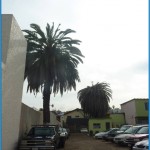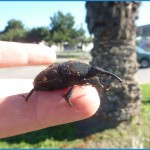
Two species of giant palm weevils, Rhynchophorus ferrugineus (commonly known as the red palm weevil) and Rhynchophorus palmarum (South American palm weevil) have both been detected in Southern California. The red palm weevil (RPW) was officially discovered in Laguna Beach in Orange County (California USA) in September 2010. The beetle has been declared by FAO as a category-1 pest of date palms in the Middle-East. RPW, native to south east Asia, has been particularly devastating following its successful invasion into Mediterranean countries in Europe and Africa (e.g., Egypt). For about one year now, the California Department of Food and Agriculture (CDFA) has been intensively monitoring for RPW in Laguna Beach with approximately 250 RPW traps baited with aggregation pheromone and fruit. These traps have failed to capture adult RPW. Visual ground inspections of palms in Laguna Beach have identified trees potentially infested with RPW. One palm was inspected on 25 May 2011 and physical inspection confirmed feeding damage from RPW, but NO live RPW were found. This palm was treated with insecticides. On 2 June 2011, a second palm displaying symptoms of RPW damage was inspected physically. Again, feeding damage was confirmed but NO live RPW were detected. This palm was also treated with insecticides.

In December 2010 reports were received from palm enthusiasts in Tijuana Mexico of dying Canary Islands palms and these moribund palms were displaying symptoms similar to that expected from a RPW infestation. Physical inspection confirmed the presence of live palm weevils in at least one palm, and this weevil was officially identified at Rhynchophorus palmarum, the South American palm weevil (SAPW). This weevil is native to Mexico, Central and South America and is a well known palm pest, especially of coconuts. This weevil has been recorded feeding on 35 plant species in 12 different families, but is found predominantly on palms. SAPW has been problematic in Puerto Vallarta where in 2008 it was apparently linked to the mortality of more than 500 coconut palms in this popular tourist area.
In addition to the damage that SAPW larvae inflict while feeding inside the palm crown and trunk, this weevil also vectors a nematode, Rhadinaphelenchus cocophilus, which causes red-ring disease of coconut. The contamination of healthy plants with red-ring disease occurs only if SAPW are present. The nematode cannot survive outside of it’s palm hosts and it is moved from palm to palm by adult weevils. The nematode may also cause disease in oil palms, Elaeis guineensis.

Following the discovery of SAPW in Tijuana, the CDFA commenced a monitoring program in San Ysidro in San Diego County (California USA) in March 2011. The area under surveillance with traps baited with SAPW aggregation pheromone is close to the USA-Mexico border. Mexican collaborators have also deployed SAPW pheromone traps in Tijuana to monitor for this pest. Monitoring efforts have trapped adult male and female SAPW weevils in San Ysidro and Tijuana that flew into traps in response to aggregation pheromone. So far no infested palm trees have been found in the San Ysidro area. Consequently, it is difficult to determine whether or not SAPW has breeding populations in San Diego County as pheromone traps may simply be catching SAPW dispersing from Tijuana into Southern California. This situation is being monitored very closely by the CDFA and the USDA.
Potentially, for the first time, an extraordinary invasion scenario may be unfolding in Southern California with respect to exotic palms and invasive palm weevils. Should RPW and SAPW establish in Southern California this will be the first time these two weevils have ever been together in the same place at the same time and potentially attacking the same palms simultaneously!
So what could this mean for the palms of Southern California? This is obviously difficult to answer, but one potential concern could be the ability of RPW to acquire from SAPW the red-ring disease nematode and spread it as well. If this happens, it may increase the vector capacity for this nematode as two weevil species instead of one could spread the nematode to susceptible palms. This could cause a severe disease epidemic for California’s palms. Should both palm weevils infest the same palm tree will this speed up the rate of palm mortality or will different larvae species attack each other while competing for food and slow the rate of palm mortality? Could both weevil species interbreed and produce less fit offspring (hybrid or outbreeding depression) or could hybridization create a more aggressive strain of palm weevil (hybrid vigor)? Finally, what is amazing about speculating over this situation is that it is an entirely a human-made problem! People have moved exotic palms to Southern California (e.g., Canary Islands palms from the Canary Islands and date palms from the Middle East), and people have facilitated the movement of exotic palms weevils from South East Asia (i.e., RPW) and Latin America (i.e., SAPW). People have also provided an ideal but highly artificial environment (i.e., irrigated urban and agricultural landscapes) for invasive weevils to potentially establish and proliferate on exotic palms in a part of the world where none of the players (i.e., palms and weevils) are native, but the climate is agreeable for their mutual co-existence.